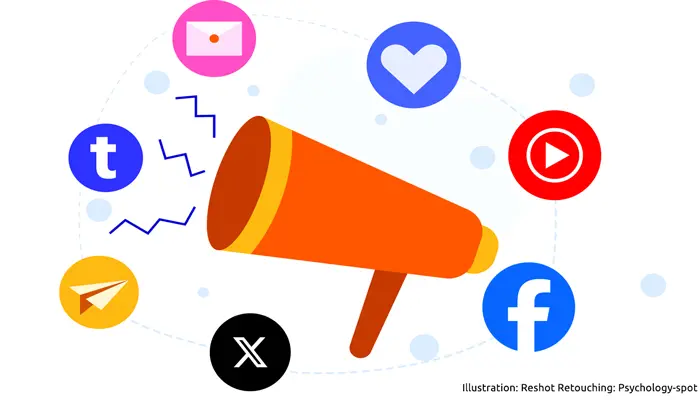
On April 15, 2013, as hundreds of runners reached the finish line at the annual Boston Marathon, two bombs exploded. Three people died that day, including an eight-year-old boy. Hundreds were injured.
The media around the world followed up the event, for days. They transmitted the terrible images of the detonation, the chaos, the pain of the victims. The people who lived through that attack suffered psychological damage, but Alison Holman and her colleagues at the University of California discovered that there was also another group of people affected.
After interviewing 4,675 adults, it was found that people who had not experienced the explosion in their own flesh, but saw 6 or more hours of news a day during the following week, also showed signs of post-traumatic stress.
The researchers concluded that “Repeated media exposure related to the bombings was associated with greater acute stress than direct exposure. Media coverage after collective trauma can widely spread acute stress.”
Therefore, it became clear to them that we all underestimated the effects of the news on our mental health. And we are not even fully aware that news also changes our view of reality, influences our attitudes, shapes our opinions, and ultimately determines our behaviors and may even affect our health.
Immersed in a constant stream of news
The current coronavirus pandemic and confinement have exposed us like no other situation to the media, which have become our only window to the world in a period of great uncertainty and loneliness. Just when we have been the most psychologically vulnerable, the news media have reached record ratings.
To the traditional media have been added other channels – social networks, podcasts and blogs – which are always available and ended up plunging us into a tidal wave of news from the time we got up until we go to bed.
In fact, one of the first studies carried out on the media coverage of the Covid-19 pandemic revealed that consumption of the new media generated more acute symptoms of depression, anxiety and stress, compared to traditional media. Researchers from Tianjin Normal University also found that it counts the way news are presented. Those that emphasized the most positive aspects or showed the content in a more neutral way destabilized us less.
Imbued into this constant flow of information/disinformation, it is not surprising that we have fallen into a particularly dangerous vicious circle. When we believe that there is a threat to our life or stability, we will be concerned and want to collect as much data as possible in order to “better” understand what is happening and make informed decisions.
The problem is that this leads us to consume more news that, when they are contradictory or sensational, instead of clarifying us, they plunge us even more into confusion.
In fact, researchers from the University of California found that people who are most concerned about the consequences of events tend to consume more news in the period before they occur, which results in worse psychological performance when the problem finally materializes. In other words, consuming more news does not usually prepare us better for the problems that lie ahead.
That, of course, does not mean that we should be misinformed. But perhaps we should approach the news with a more cautious and critical attitude.
The news takes advantage of our biases
One of the reasons why the news effects are so powerful is our “negativity bias.” It’s about our tendency to pay more attention to the negative things happening around us. That bias is likely because we need to protect ourselves from danger, which is why we focus more on the negative news and quickly dismiss the positive.
However, a bias is not reality, it is a limited perception of it. In fact, researchers at the University of North Carolina found that the economic news transmitted by the media are often darker than reality, so that it ends up influencing negatively our expectations for the future. A lot of news, therefore, deforms our perception of the world – and not necessarily for the better.
The news also makes cam in the “framing effect“, a psychological phenomenon that indicates that the way they present us a fact or choice influences the way we think about it.
In 2016, two researchers from the University of Bournemouth presented the same news to a group of people, but framed differently, to assess their perception of a country’s level of risk.
They found, for example, that saying that a terrorist attack was caused by “al-Qaeda and associated radical Islamic groups” was of far greater concern to people than referring more loosely to a “national rebel separatist group”, although both headlines have the same meaning and its consequences were the same.
A study by the Moffitt Cancer Center in Florida found that the news also leads us to misinterpret the incidence of different types of cancer. In fact, we tend to think that brain cancer is much more common because it is over-represented on the media, while others, such as tumors in the reproductive system, which occur more frequently even among people we know, seem less common to us. That biased perception could lead us to underestimate our level of risk and overlook the first warning signs. That means that the effects of the news also extend to our health.
The effects of the news on our health
An investigation conducted at the Louis-H Hospital. Lafontaine in Montreal found that reading negative news for as little as 10 minutes produces an increase in cortisol production, the stress hormone, in women. This news are also remembered more clearly, which means that our brain perceives them as a threat.
Another study conducted at the University of Missouri found that negative news increases our heart rate, which could have serious long-term implications for our health if we continually expose ourselves to an avalanche of negative news day after day. In fact, an exposure of 4 hours or more to media coverage of the September 11 attacks increased by up to 53% the chances of having cardiovascular problems for the next three years and other health problems.
It is not weird. We see the same news, over and over again. We know it is not fiction. There is someone who is suffering or having a bad time. And that ends up leaving an emotional mark that can have an impact on our health.
Another study developed at the University of Texas found that the exposure to the media was a predictor of anxiety levels. These people reported lower levels of optimism and greater psychological distress.
In reality, the problem is not the news itself, but its repetition. The bombing. New traumatic details added to get attention. Because the news has long since forgotten its main purpose, to inform, and has become one more source of entertainment to which it is necessary to add drama to keep us glued to the screens. In fact, after analyzing the news in 14 countries, psychologists from the National Taiwan University warned that the sensational treatment of the news has increased exponentially in recent years.
And no one is immune. Although some are more suggestible than others, psychologists from the Open University of the Netherlands found that the news affects our mood, generating negative emotions and erasing positive ones, regardless of our personality characteristics.
Therefore, in the infoxication era, we need to take a proactive attitude, which could mean reducing the consumption of news and/or choosing reliable sources that really inform us instead of just generating alarm or adding morbid details. Our mental and physical health will thank us.
Sources:
Gorvett, Z. (2020) How the news changes the way we think and behave. In: BBC.
Hoog, N. & Verboon, P. (2020) Is the news making us unhappy? The influence of daily news exposure on emotional states. British Journal of Psychology; 111(2): 157-173.
Chao, M. et. Al. (2020) Media use and acute psychological outcomes during COVID-19 outbreak in China. Journal of Anxiety Disorders; 74: 102248.
Thompson, R. et. Al. (2019) Media Coverage, Forecasted Posttraumatic Stress Symptoms, and Psychological Responses Before and After an Approaching Hurricane; JAMA; 2(1): e186228.
Kapuściński, G. & Richards, B. (2016) News framing effects on destination risk perception. Tourism Management; 57: 234-244.
Holman, E. A. et. Al. (2014) Media’s role in broadcasting acute stress following the Boston Marathon bombings. PNAS; 111 (1): 93-98.
Jensen, J. D. et. Al. (2014) Public Estimates of Cancer Frequency: Cancer Incidence Perceptions Mirror Distorted Media Depictions. Journal of Health Communication International Perspectives; 19(5): 609-624.
Cohen, R. et. Al. (2013) Mental- And Physical-Health Effects of Acute Exposure to Media Images of the September 11, 2001, Attacks and the Iraq War. Psychol Sci; 24(9): 1623-1634.
Marin, M. et. Al. (2012) There Is No News Like Bad News: Women Are More Remembering and Stress Reactive After Reading Real Negative News Than Men. PLoS One; 7(10): e47189.
Wang, T. (2012) Presentation and impact of market-driven journalism on sensationalism in global TV news. International Communication Gazette; 74(8): 711-727.
Hester, J. B. & Gibson, R. (2003) The Economy and Second-Level Agenda Setting: A Time-Series Analysis of Economic News and Public Opinion about the Economy. Journalism & Mass Communication Quarterly; 80(1):73-90.
Bolls, P. D. et. Al. (2001) The Effects of Message Valence and Listener Arousal on Attention, Memory, and Facial Muscular Responses to Radio Advertisements. Communication Research; 28(5): 627-651.
McNaughton-Cassill, M. E. (2001) The news media and psychological distress. Anxiety, Stress & Coping: An International Journal; 14(2): 193–211.



